Questionwhere can i find info on king sheperds my sheperds weighs in at 111 lbs want more info on them thank you.
AnswerHi Mary
This is not a recognized breed by the AKC IT IS IN RARE REGISTRY ONLY.
they are somewhat short legged breed with long hair or coats and sturdy dogs of a different breed than the normal German Shepherds.
http://www.kingshepherd.com/
THIS RARE BREED ONLY BECAUSE THE AKC DOES NOT RECOGINZE IT TO REGISTER IT TO PARTICATE IN AKC EVENTS OF SHOWS, ETC. IT IS WAY OVER SIZED OF THE STANDARD SHEPHERDS WEIGHT, COATS, HEIGHT, ETC. I HAVE COPIED SOME INFO FOR YOU TO UNDERSTAND WHY MOST GERMAN SHEPHERDS FROWN ON THIS RARE BREED IS BECAUSE IT IS WAY OUT OF WHAT WE ARE STRIVING FOR TO HAVE GOOD HEALTH, LESS HIPS AND JOINT PROBLEMS, HEART, THYROID, ETC. THE LARGER THE WORSE PROBLEMS ONE HAS WITH ANY BREED, LESS LIFE TIME ALSO. THE MORE UNDER 100 LBS IS BETTER ON JOINTS, HEART, ETC.
AMERICAN KING SHEPHERD CLUB STANDARD OF THE BREED
GENERAL CHARACTERISTICS
The King Shepherd's origin comes from several different breeds. Although there are some differences in opinion regarding the exact breed make-up, it is generally believed that the King's breed make-up includes German Shepherds of American lines, crossed with Malamutes and/or a Flock Guardian breed (i.e Great Pyrenees), which were then bred back to German Shepherds of European descent.
The head should be immense and well defined. The build of this breed is heavy bodied, heavy boned, slightly long, robust and muscular; the structure is solid. The proportion between height and length, and the angulation of the bone elements, must be in such a relationship as to guarantee easy trotting and ruggedness. The coat should be highly weather-resistant. The sexual characteristics should be well marked. A dog that fulfills the requirements of the standard should give the impression of strength and vigor, of intelligence and agility, and should also be well proportioned.
The general behavior of the dog and his movements should indicate complete physiological soundness--a quality, which makes the King Shepherd particularly fitted to carry out his tasks as a working dog continuously and willingly. His natural exuberance should be tempered by obedience and by the pleasure he takes in carrying out any task, adapting himself with good will to every situation. In the defense of his master and his master's property the King Shepherd should show courage and hardiness in his role of protector. At the same time he must be an agreeable companion in familiar company, vigilant, faithful and friendly toward children and other animals. He should also be at ease in the presence of strangers, and in such behavior he will give an impression of self-confidence and natural nobility.
ANGULATION AND GAIT
The King Shepherd's gait should be very strong and powerful; not a flying trot, nor a graceful, flowing gait. He is a trotter, and consequently his gait is diagonal (which means that he has two diagonally opposite feet on the ground while the other two diagonally opposite feet are off the ground). His limbs should be harmonious and angulated in such a way as to make it possible for him to move his hind legs as far forward as the midpoint of the trunk, and to extend the forelegs to the same degree, without noticeable displacement of the topline.
The proper proportion between height and length and an adequate and well-proportioned length of the limbs permit a trot that covers a lot of ground, stays close to the ground, and gives the impression of easy movement with minimum effort. In a dog that trots with his head pushed forward, and with his tail slightly raised, the movement is homogeneous and tranquil; as he moves, his back describes a gently waving line which extends harmoniously from the point of the ears to the tip of the tail, following the nape and the back.
Paddling when moving forward is a very severe fault. The tail curling above the horizontal plateau of the topline while gaiting (while in movement) is a very severe fault.
BEHAVIOR AND CHARACTER
The chief qualities of an outstanding dog are: a well-balanced nervous system, readiness, lack of inhibition, vigilance, faithfulness, incorruptibility, together with courage, combatively, and cleverness in defense. These are the characteristics, which together make the King Shepherd such a fine working dog and, particularly, a watchdog, companion, guard dog and sheep-herder.
HEAD
The head is one of the most important characteristics of this breed. The head should be immense and well defined. It is in good proportion to the body and moderately wide between the eyes. The forehead, seen from the furrow is moderately well defined. The cheeks are not too full, are moderately curved and when viewed from the top should be much in the form of a trapezoid, not triangular, and well filled in under the eyes. When the head is viewed in profile, the muzzle should tend more towards a square shape, than wedge shape.
There should be plenty of substance in foreface, with a good depth from top to bottom. The muzzle should be squarer, more so than longer. The muzzle is very powerful in proportion to the rest of the head, with a well-defined stop.
When considering the head for the dog or bitch, a shorter, broader muzzle is required, other than that of a long narrow muzzle. The lips are well drawn and the teeth are very strong, with the incisors meeting in a scissors bite; the jaws must never be undershot or overshot. Full dentition is not required. However if 2 dogs are equal in every other respect the dog with full dentition is to be preferred.
A long, or narrow muzzle is a disqualifying fault.
EARS
Of medium size, moderately wide at the base, set on high and pointed; they are carried erect and slightly forward. The ears should be thick and firm and should not be too large or too small in proportion to the head. The ideal carriage should be one in which the centerlines of the ears, viewed from the front, are from 5-1 0 degrees parallel to each other and perpendicular to the ground. Kite ears (those that point east and west, away from the center of the head, more than ten degrees off center) are considered a serious fault. Dogs with hanging ears or clipped ears are to be eliminated (puppies up to the age of 4-6 months, and sometimes older, do not carry their ears completely erect, until teething is completed).
Wide & kite-like ears, off to the side of the head is a very severe fault.
EYES
Of medium size and almond-shaped set somewhat aslant and not protuberant, as nearly as possible matching the surrounding coat; in shades of brown, from very light to dark are acceptable. The expression should be one of liveliness and intelligence.
NECK
Robust, of medium length joining the head with sharp angles. Neck muscles are well developed and fitting gracefully into the body without throatiness. The neck is carried erect when the dog is excited, normally being carried horizontally.
TRUNK
The chest should be extremely deep, broad and wide. The ribs are never flat or barrel-shaped. The belly is moderately drawn up. The back (including the lumbar region) is straight and well developed; it must not be too long between withers and croup: the length of the trunk is greater than the height at the withers. Dogs with square body outline or high on their legs should be rejected. - The loins are broad and robust, the croup is moderately long and slightly hollowed.
A thin, narrow or hollow chest is a very severe fault.
TAIL
Thickly feathered, the tail reaches at least to the hocks. The tail is carried down and slightly curved; when excited or in movement, the dog raises the tail, which becomes more curved, without however going beyond the vertical. It must not, moreover, lie on or curl up on the back. Docked tails are inadmissible.
Curled or hooked tail when stacked, (i.e., tip of tail curling up when in a relaxed state) and the tail curling above the horizontal plateau of the topline while gaiting (while in movement), is a very severe fault.
FOREQUARTERS
The forequarters should be very heavy boned. The shoulders are moderately long, sloping flat, close to the body and not thrown forward; with the upper arm, they form nearly a right angle. The upper arm and the shoulder should both be well muscled. The forearm seen from any side should be straight. The pastern is solid but not too straight; the elbows, should turn neither in nor out, nor should they be pinched or too close to the body. Overly heavy bone of greater density like that of a Newfoundland not a Flat Coated Retriever or a Great Pyrenees not a Kuvasz is desirable.
Toes or feet pointed east & west, too narrow and pinched elbows while stacked are very severe faults.
Any dog or bitch whose forequarters are not heavily boned should be severely faulted.
HINDQUARTERS
The hindquarters should be very heavy boned and moderately angulated. The thighs are broad, and strongly muscled. The femur is rather long and seen from the side, oblique in relation to the tibia, which should be of proportional length. The tarsus and metatarsus are solid and robust.
Cow hocked rear when stacked (i.e., hocks pointed inward) or when moving away is a very severe fault.
Any dog or bitch whose hindquarters are not heavily boned should be severely faulted.
Excessive angulation in the pasterns or the hindquarters is a very severe fault.
PAWS
Round, short, well closed, arched. The pads are very hard. The nails are short and strong, generally dark in color. Front dewclaws are neither a fault nor a virtue. Since hind dewclaws if any, may hamper the gait, it is recommended that they should be removed at birth.
COLOR
The King Shepherd comes in a wide range of acceptable colors. These are as follows: Sable (a brownish tan with brown or black markings or a grayish silver with black markings); bi-colored (predominantly black with red, tan or cream); black saddle with red, tan, gold, cream, or silver markings; solid black and solid white.
Strong, rich colors and pigments are highly preferred.
Small white spots on the chest, feet or tail are acceptable. Pale, washed-out colors except solid white are serious faults. The undercoat is invariably colored, except in black dogs. Blue or liver colored dogs or a dog with a nose that is not predominantly black must be disqualified. Puppies change color from birth until they get their final coat.
COAT
Coarsehaired variety: the topcoat is as dense as possible. Each single hair should stand straight and close to the body. On the head the hair is short, as also on the inside of the ear, the forward side of the legs, the paws and the toes, while on the neck the hair is longer and denser. On the hindquarters and buttocks the hair is longer, down to the pastern or the metatarsus: the thighs are moderately trousered. The length of hair varies from one dog to another, and thus there are many types within the single variety.
Longhaired variety: the coat is longer than on the preceding variety, not always completely straight, and especially not close to the body. The individual hairs are noticeably longer, particularly inside the ears and behind them, on the back part of the forearm and often in the lumbar region: they form tufts at the ears and fringes from the elbow to the pastern. The trousers are long and dense. The tail is densely feathered with light fringe below.
There is no hard and fast rule for the length of the hair but short, moletype coats are faulty.
SIZE
The minimum height for males is 27 inches, at the highest point of the shoulder blade, with an ideal height of 29 inches or more preferred. For females the minimum height is 25 inches, at the aforementioned point, with an ideal height of 27 inches or more preferred. Any male or female not meeting the minimum height requirements must be disqualified.
The minimum weight for dogs should be not less than 100, pounds at maturity, with the ideal weight being 120-145 pounds. Minimum weight for females is 80 pounds at maturity, with the ideal weight being 90-110 pounds. Note: Larger dogs are desirable, providing that proper type (conformity to the King Shepherd Standard) and soundness is present.
Greater size is desirable. Overall appearance should be one of a very large, blocky shepherd type dog.
DISQUALIFYING FAULTS
Any male measuring less than 27 inches at the shoulders or any female measuring less than 25 inches at the shoulders.
Any unreasonable expression of, or any form of, fear or sharp shyness.
Dogs with hanging ears or undershot or overshot bite.
Blue or liver colored dogs or dogs with lack of pigmentation except solid white coated, or having a nose that is not predominantly black.
A docked tail, or one that curls forward above the vertical line from the croup.
Any dog that attempts to bite the Judge.
A long, or narrow muzzle.
KIND REGARDS
PATT
WWW.SCHREKNHAUS.COM

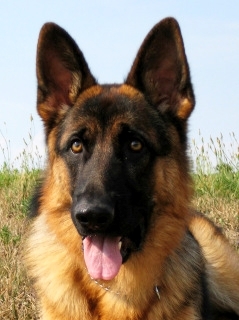 2yo German Shepherd Male
Question
My Boy...
Hi there....I have a 2 year old, pur
2yo German Shepherd Male
Question
My Boy...
Hi there....I have a 2 year old, pur
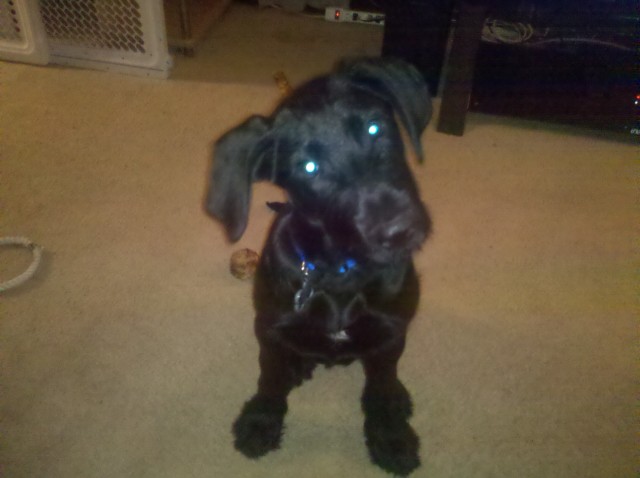 purebreed german shepherd?
Question
king
I purchased a dog 2months ago and he weig
purebreed german shepherd?
Question
king
I purchased a dog 2months ago and he weig
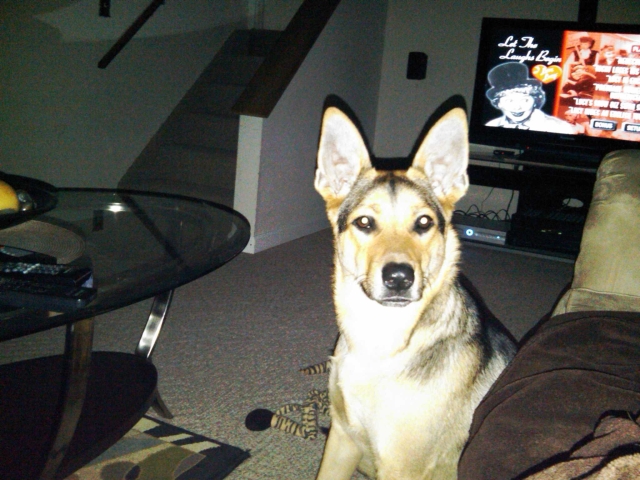 My German Shepherd Acts Scared
Question
Mannie
I have a male 1/2 German Shepherd 1/2 H
My German Shepherd Acts Scared
Question
Mannie
I have a male 1/2 German Shepherd 1/2 H
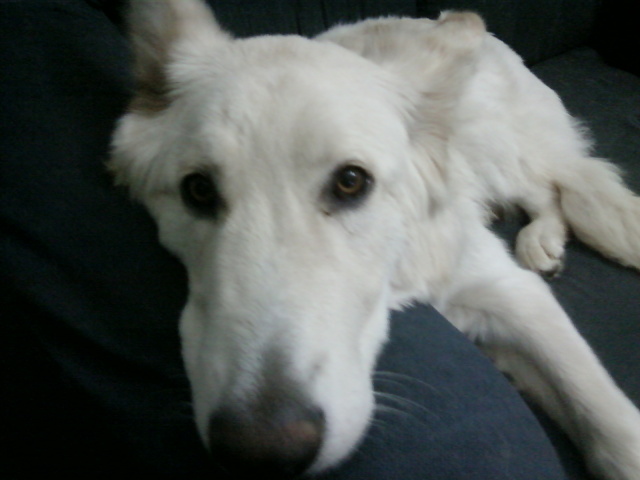 A traumatic experience
Question
Kelsie
Hi, we have two dogs and the second one
A traumatic experience
Question
Kelsie
Hi, we have two dogs and the second one
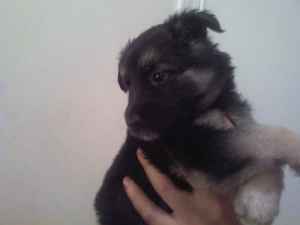 interested in adopting a puppy GSD.
Question
pic of the gsd puppy
Hey, im considering adopt
interested in adopting a puppy GSD.
Question
pic of the gsd puppy
Hey, im considering adopt